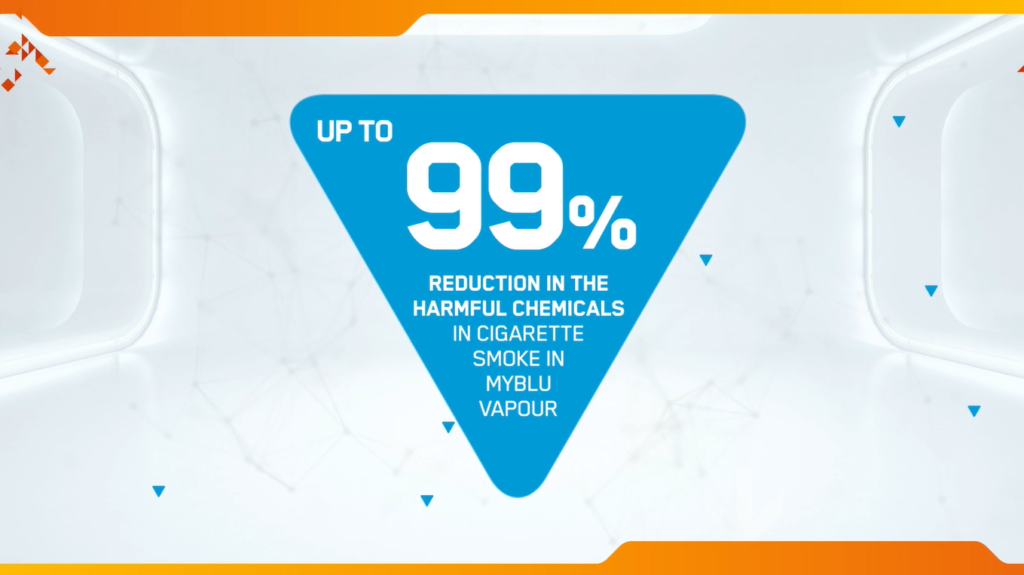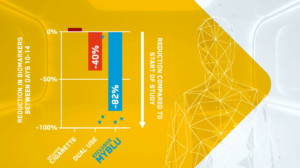//Clinical study demonstrates significant reductions in exposure to harmful chemicals vaping myblu compared to combustible cigarettes
Posted 09/05/2022 12:00am
NEW HUMAN CLINICAL DATA DEMONSTRATES RAPID AND SIGNIFICANT REDUCTIONS IN SELECT DISEASE-RELATED BIOMARKERS OF EXPOSURE TO HARMFUL CHEMICALS WHEN ADULT SMOKERS EITHER FULLY OR PARTIALLY TRANSITION TO VAPING, AS WELL AS DRAMATIC REVERSALS OF THESE RESULTS IF SMOKING IS RESUMED.
Vaping offers adult smokers a potentially harm reduced method of nicotine delivery. A comprehensive, rolling Cochrane Review consistently finds these devices help smokers to quit with no serious harm or unwanted effects up to two years of usage.

Previous vape aerosol research around myblu was encouraging.
Our previous research demonstrates machine-generated vape aerosols contain fewer and substantially lower levels of harmful chemicals compared to cigarette smoke. However, it’s important to understand whether these laboratory observations translate directly when adult smokers transition to vaping – either completely or partially – as well as what happens when combustible cigarette smoking is resumed.
In clinical studies, the presence of harmful chemicals can be measured using established and well understood biomarkers of exposure. Imperial Brands Science therefore conducted a two-week controlled clinical study to investigate, the results of which have been published in the peer-reviewed journal Internal and Emergency Medicine.
The randomised, open label study observed 14 biomarkers of exposure to select harmful chemicals in 72 healthy US adult smokers aged 21-65 years. It was overseen by the independent clinical research organisation Celerion in two US-based clinical research centres, who provided independent data collation.
All subjects were residents at the clinics for the full duration of the study, and were not permitted to use any other nicotine or tobacco products. This was an attempt to ensure the resulting clinical data was more accurate than that obtained through certain other methodologies, like self-reported questionnaires.
The study also sought to recreate realistic conditions under which adult smokers abstain from cigarettes and transition to vapes. For instance, vapers tend to use a variety of flavours, so participants were able to choose from 16 commercial e-liquids in a variety of freebase and nicotine salt formulations. This approach was consistent with evidence that access to a broad portfolio of flavours and nicotine strengths can optimise tobacco harm reduction (THR) in adult smokers.
The first phase of the study involved the participants abstaining from combustible cigarettes, and instead vaping myblu exclusively for nine days. Blood and urine samples were taken at the end of this period to measure levels of biomarkers.

Significant reductions in biomarkers of exposure were observed when adult smoker subjects switched to vaping myblu.
Researchers initially measured subjects’ biomarkers of exposure to a number of harmful chemicals – including carcinogens and respiratory and cardiovascular toxicants – present in blood and urine. Following the initial nine days of exclusive myblu use, all subjects experienced rapid and significant reductions in biomarkers of exposure to 14 select harmful chemicals.
In fact, levels of biomarkers were reduced by 46-97% compared to previous combustible cigarette usage, with an average of 84%.
In the second phase of the study, participants were divided into three distinct groups for a further five days:
- The first group continued to vape myblu exclusively.
- The second group engaged in dual use, replacing up to 50% of their previous combustible cigarette usage by vaping myblu.
- The third group recommenced smoking combustible cigarettes exclusively.
At the end of the study (day 14), further blood and urine samples were obtained. The following results were observed:
- Reductions in exposure to harmful chemicals were sustained in those adult smokers (n=25) who continued to vape myblu exclusively.
- Adult smokers who both smoked and vaped at a 50:50 ratio (n=24) demonstrated reductions in biomarkers – between 5% and 59% (and an average of 40%), which were broadly proportional to their reductions in cigarette consumption.
- Adult smokers who recommenced smoking exclusively (n=21) once again rapidly increased their exposure to harmful chemicals, reversing any reductions achieved in the study’s first phase.

The data clearly demonstrate transitioning to myblu results in less adult smoker exposure to harmful chemicals.
Senior Regulatory Writer and study author Fiona Chapman comments: “The data clearly demonstrate substituting combustible cigarettes for myblu results in rapid and substantial reductions in biomarkers of exposure to select harmful chemicals in adult smokers, while also achieving satisfying levels of nicotine delivery.
“Meanwhile, the second phase of this specific study demonstrates reductions in biomarkers of exposure to harmful chemicals are sustained through continued myblu usage.
“Finally, resuming the exclusive smoking of combustible cigarettes rapidly results in the dramatic reversal of these reductions.”
Florence Greep, Imperial Brands EVP Category Director, concludes: “As part of our commitment to make a meaningful contribution to harm reduction, Imperial Brands continues to encourage policy makers and regulators around the world to consider this study in the context of the growing scientific evidence base around non-combustible nicotine products.
“Hopefully, data like these results in the advocation of public health policies that facilitate THR for those millions of current adult smokers who – through our detailed consumer-focused insights – have revealed they may consider transitioning to potentially harm reduced alternatives like myblu.”
For a video summary of the research, see below:
You are free to share this content with credit to Imperial Brands under a Creative Commons Attribution-NoDerivatives 4.0 International (CC BY-ND 4.0) license.

